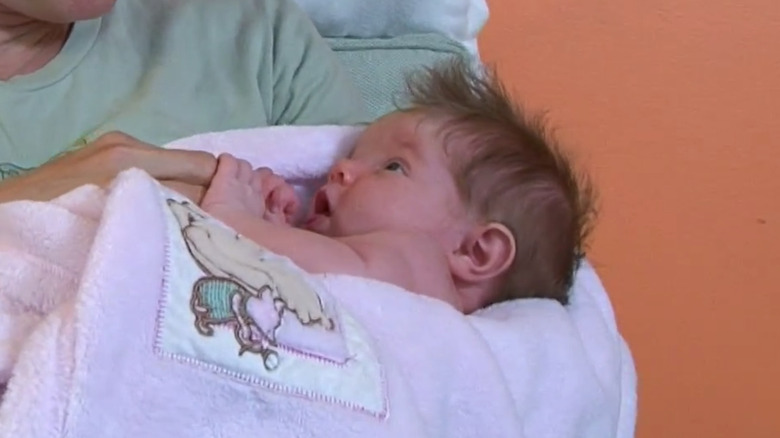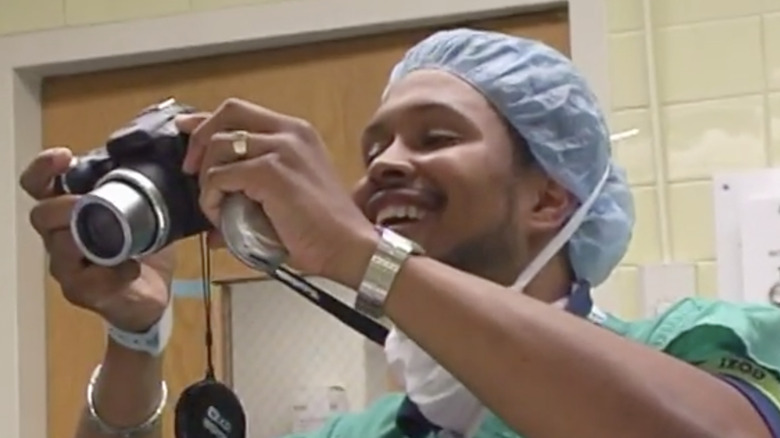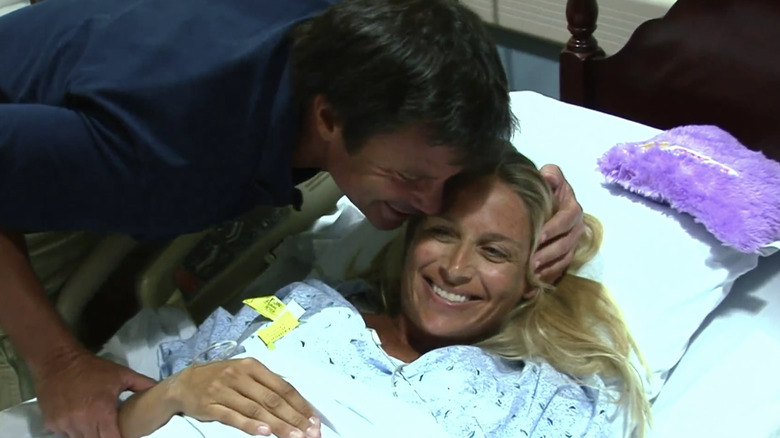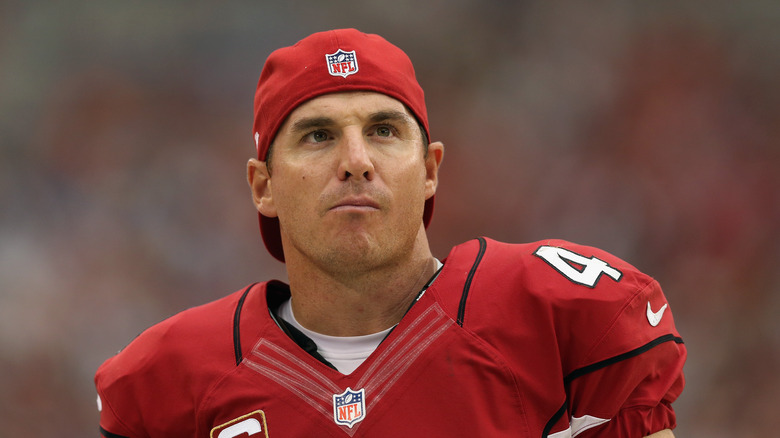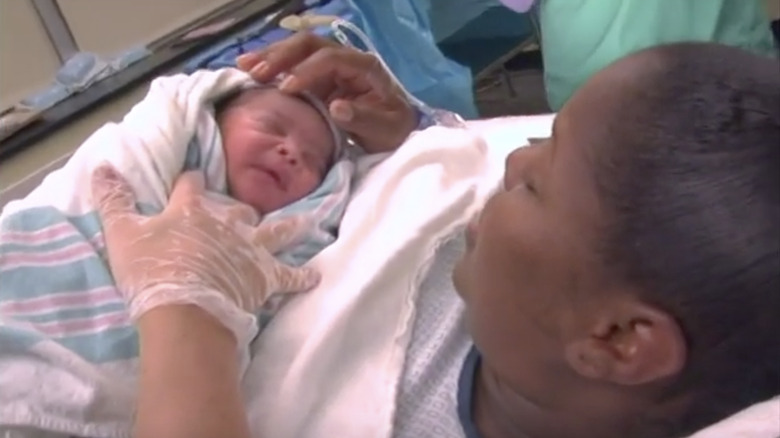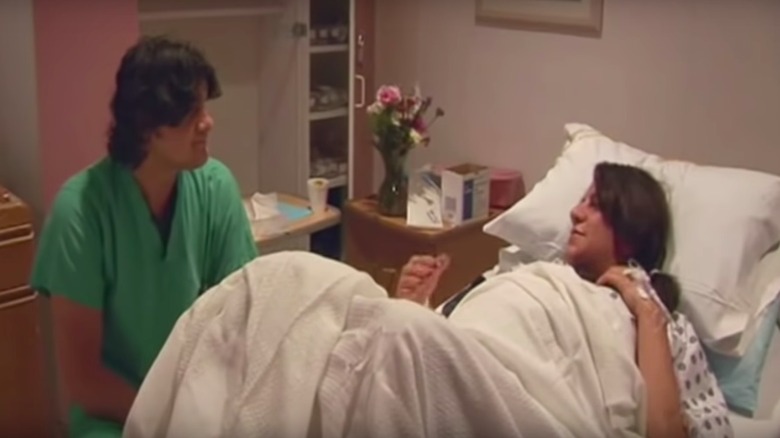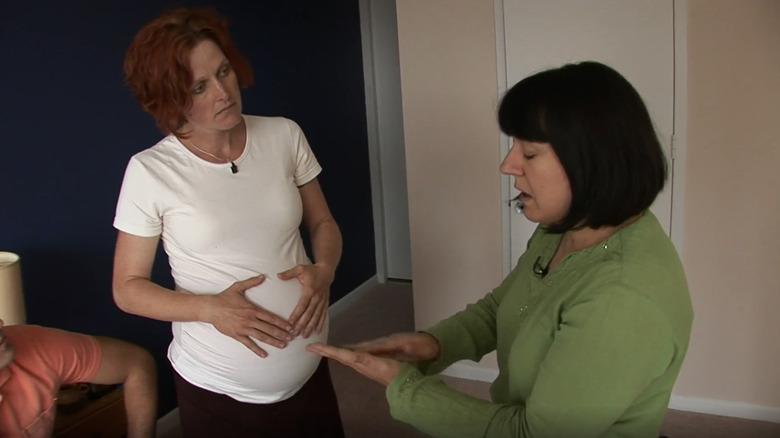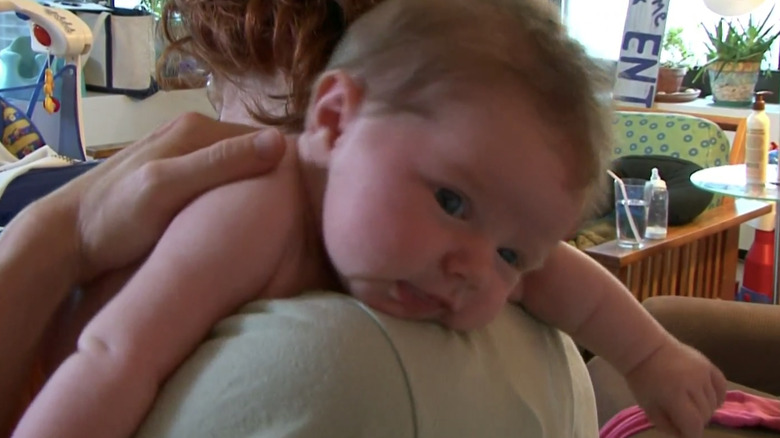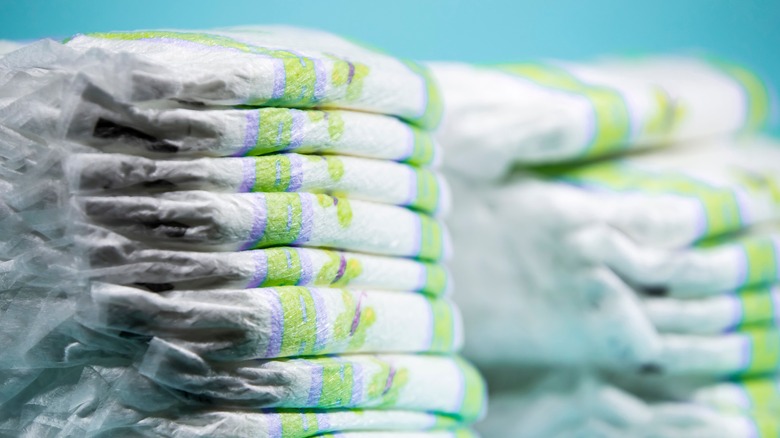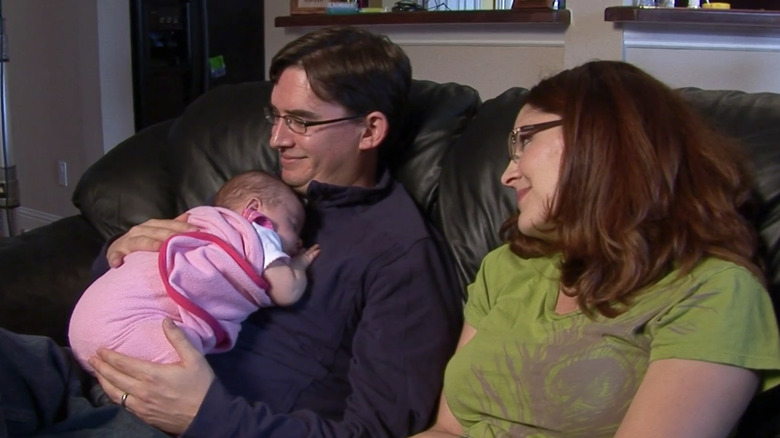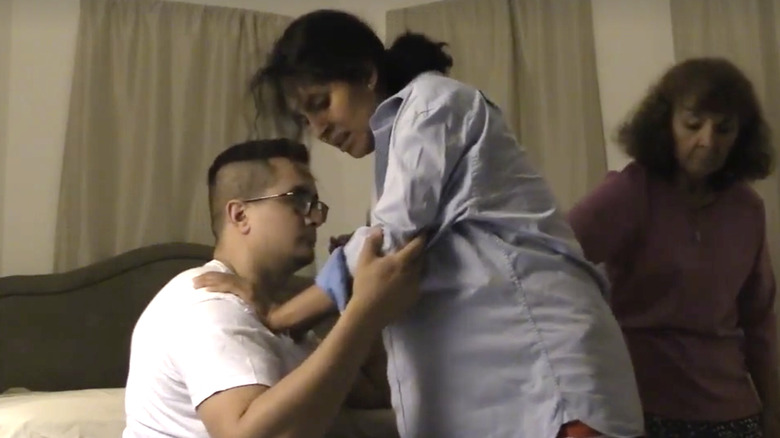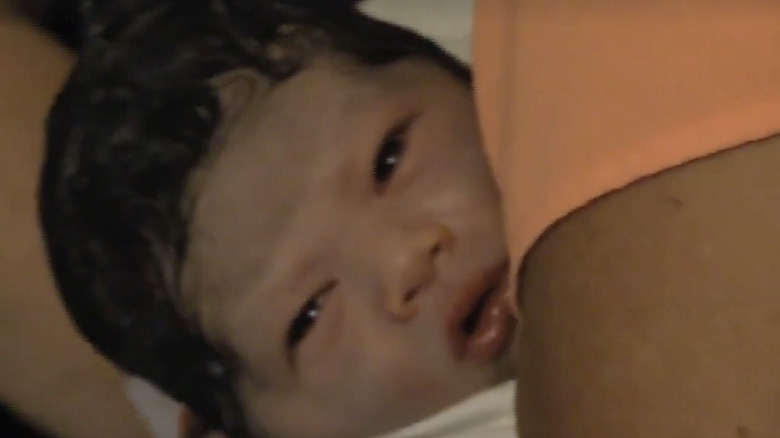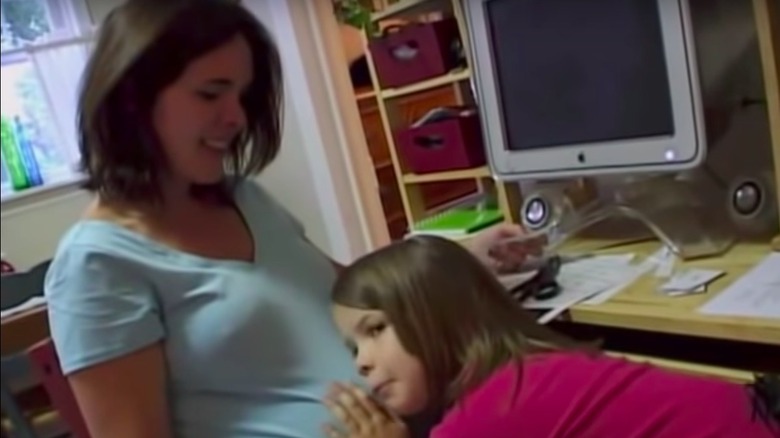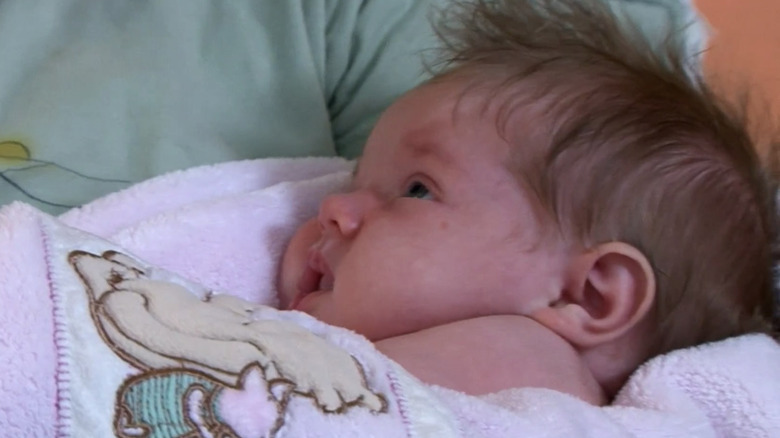The Untold Truth Of TLC's A Baby Story
We may receive a commission on purchases made from links.
Who remembers TLC's A Baby Story? As the home of such reality TV fare as Here Comes Honey Boo Boo and 90 Day Fiancé, it's easy to forget that TLC was once an acronym for The Learning Channel, originally founded in 1972 by NASA and the U.S. Department of Health, Education and Welfare to broadcast educational programming. It was during its more-highbrow era that TLC debuted the groundbreaking documentary series chronicling birth.
A Baby Story launched in 1999, with TLC's website saying the show "follows couples through their final weeks of pregnancy, joins them in the delivery room and through the first weeks of a new life" as they "share their experiences and all the emotions they feel when they first greet their newborn." According to company behind the show, Pie Town Productions, A Baby Story "is much more than a television show." The website explained, "It is an emotional experience that educates and enlightens its viewers about the miracle of childbirth on a personal level."
As popular as the show was, there's still a lot that viewers don't know. Read on to learn the untold truth of A Baby Story.
TLC's A Baby Story was trailblazing reality TV
According to Pie Town Productions, which created the show, each half-hour episode of TLC's A Baby Story "follows one expectant couple through the highs, lows and comic moments of pregnancy, labor and bringing home the baby." While the concept was deceptively simple, it was also somewhat radical given concerns that viewers would be offended by pregnancy, dating back to the days when I Love Lucy concealed the pregnancy of its star (via The Washington Post).
In a 2002 interview with Canada's The Globe and Mail, TLC's then-general manager Jana Bennett credited the burgeoning popularity of the video camera, encouraging expectant parents to film their experiences, for ushering in a societal attitude shift that allowed the word "pregnant" (once banned on television) to replace the more genteel "expected." This, she said, opened the door for A Baby Story — and likely the flurry of pregnancy-themed series that followed, ranging from I'm Pregnant and... to Birth Stories. "What we're talking about here is a fundamental drama: the struggle of birth," explained Bennett of the show's appeal. "It's a huge threshold for anyone to cross. It's scary and rather mysterious. All those things make it quite appealing."
What it's like to have a birth filmed for TLC's A Baby Story
As TLC's A Baby Story's popularity grew, so too did the number of expectant parents eager to be participants. However, unless your last name is Kardashian, exposing every aspect of one's private, personal life to a camera crew is an understandably weird experience. This was certainly the case for the reality TV pioneers who agreed to be filmed for A Baby Story, and was especially true when it came to filming labor — not exactly any woman's most glamorous moment. Yet amazingly enough, couples actually wanted to open their lives to A Baby Story during what was arguably some of their most intimate times.
"The tapings were a little time-consuming and distracting from the pregnancy," Chip McKay told Times Herald-Record of him and wife Allison being followed by a camera crew as the due date approached. "They filmed me being prepped, the IV being inserted. There were interviews with my doctors," said Allison, pointing out that the crew was very respectful when it came to giving the couple privacy when they needed it.
"They let us keep those private moments private," Chip said. "They were very cooperative."
An NFL star and his wife were featured on TLC's A Baby Story
Among the numerous couples to open their lives to TLC's A Baby Story were New York Giants place-kicker Jay Feely and wife Rebecca, who shared their pregnancy, birth, and postnatal experiences with millions of viewers. While many people would understandably want to keep those moments to themselves, the Feelys felt it was important that others witness their birth story for deeply personal reasons.
As they told The New York Times, the couple's first pregnancy ended in a miscarriage. Their second, which was filmed for the show, resulted in daughter Pamela, named for Rebecca Feely's sister, who died of a brain aneurysm at 18 when Rebecca was just a toddler. "There is so much more to life than football, and we just wanted to highlight that," Rebecca Feely told the Times. "Whether it's the death of a sibling or the birth of a baby, it's such [an] opportunity to see God's hand in it, the bigger picture in life." Added Jay, "It's just another avenue, another opportunity for us to have an impact on people, hopefully share with people, and express our faith through the beauty of having a child."
More than 300 births were documented on TLC's A Baby Story
While Pie Town Productions declared that 200 births were documented on TLC's A Baby Story, that number later ballooned to more than 300. With A Baby Story debuting in 1999, it doesn't take a math whiz to figure out that some of those babies are now old enough to be heading to college. All those births contributed to A Baby Story becoming television's top-rated cable show for women 18 to 35, a remarkable accomplishment for a series that paved the way for the baby-related programming that followed.
Among these was TLC's World Birth Day, a two-hour spinoff special that ran on New Year's Day 2002, showcasing births from all over the globe. "Babies are born in cities around the world: In the U.S., U.K., Brazil, Ethiopia, India, Germany, China and Mexico," noted IMDb. "World Birth Day chronicles the medical and social story of the first day of the rest of the lives of babies who share the same birthday but will lead very different lives." TLC general manager Jana Bennett told The Globe and Mail that World Birth Day was TLC's highest-rated special event ever at the time.
TLC's A Baby Story was accused of dumbing down the complexities of birth
While the growing popularity of TLC's A Baby Story may have encouraged a new openness about pregnancy, there were those who felt the show was actually duping women into a false sense of complacency about the risks of childbirth. "I thought I had a good handle on it," blogger and activist Katie Vigos told the Deseret News about the expectations of labor she gleaned from A Baby Story. "The only reference I had was what I'd been exposed to in the media, and they're all alike — a woman on her back, screaming."
That was the tip of the iceberg. Academics placed A Baby Story under an analytical microscope, with the University of Minnesota's Emily M. Winderman publishing a paper in Feminist Media Studies criticizing the show for "offering a standard episodic structure for understanding a complex birth experience," essentially accusing the series of giving women specific expectations for an experience that can be far less predictable than depicted on screen.
TLC's A Baby Story educated viewers about alternative birthing techniques
If TLC's A Baby Story gave some women unrealistic expectations about childbirth, the show also offered knowledge they might otherwise not have attained, especially in the area of alternative birthing methods. This was the case for Dawn and Mike Manning, who agreed to have their son's birth filmed for the show after deciding to deliver their baby via "HypnoBirthing," a technique that "emphasizes natural childbirth and teaches self-hypnosis techniques to combat fear and pain during labor."
After the traumatic birth of her first child — which required an epidural, forceps, and stitches — Dawn Manning sought other options when she became pregnant a second time, and wanted to get the message out to other expectant moms by sharing her birth journey on A Baby Story. "I thought it would be a neat way to document his birth and a way to let women know they have more choices," Dawn told the Beverly Review, insisting that women deserve to have the opportunity to make an "informed choice" about delivery options. She noted, "There's a lot to be said about women having a choice. The first time I gave birth, I didn't know my options."
TLC's A Baby Story broke new ground by featuring a lesbian couple
In the late 1990s and early 2000s, LGBTQ representation on television was rare but on the rise, and TV taboos were shed in 2001 when TLC's A Baby Story showcased its first-ever gay female couple.
In a 1999 interview with LGBTQ publication The Advocate, Pie Town Productions president Tara Sandler and vice-president Jennifer Davidson — an openly gay couple themselves — said they were seeking a lesbian couple for the show but hadn't yet found one, expressing their worries about whether viewers had reached that level of acceptance. "I would really be concerned, to be honest, for a lesbian or gay couple going on camera with a baby," said Davidson. "I think that pushes too many buttons in this country."
Things had clearly changed just two years later when the show finally introduced its first lesbian couple, Ali and Kim, with The Advocate writing about "their process of having children through the help of a fertility specialist and an anonymous donor ... as they plan for a second daughter — from the same sperm donor, so the children would be biological siblings..."
How TLC's A Baby Story led to a branded-product bonanza
The success of TLC's A Baby Story not only led to a variety of baby-themed shows hitting the airwaves, but it also created an opportunity for TLC to generate additional revenue in some unanticipated ways. A 2010 press release from Discovery Networks, corporate parent of TLC, announced the arrival of TLC Baby, an "extension of the network's popular baby programming" that was designed to "provide parents with all the essentials to care for and raise their new bundle of joy."
In this new venture, TLC partnered with Big Tent Entertainment to develop "a comprehensive consumer products program for TLC Baby that represents practical items for 'the everyday life, made simpler.'" Elizabeth Bakacs, vice president of licensing for Discovery commerce, shared, "TLC Baby is a natural extension for the TLC brand," adding, "New and expecting moms have connected emotionally with TLC's programming because it showcases real-life experiences and helps prepare them for life with a new baby. Now the TLC Baby brand will offer viewers practical, high-quality products that they can use in their everyday lives at home, from a brand they trust."
TLC's A Baby Story spawned a spinoff
As the show's original production company, Pie Town Productions, pointed out on its website, A Baby Story was "the #1 rated cable television program for women aged 18-35 in its first season on TLC." Soon enough, TLC launched a spinoff that focused on the period immediately after childbirth, following couples in the crucial hours after welcoming their child into the world.
Bringing Home Baby premiered in 2005, with TV.com describing the show as focused on "those first 36 hours at home" with a new baby as fledgling parents dive into the deep end when they're suddenly forced to figure out everything from how to properly change diapers to breastfeeding to trimming a newborn's fingernails — usually with in-laws and relatives hovering over their shoulders to let them know that they're doing it all wrong. "It's part bundle of joy [and] part bundle of nerves when you're Bringing Home Baby," noted TV.com.
Bringing Home Baby proved to be a moderate hit for TLC. While not as successful as TLC's A Baby Story, the show nonetheless enjoyed a multi-year run until its cancellation in 2009.
TLC's A Baby Story made a comeback in a whole new way
Several years after the show left the air in 2010, TLC's A Baby Story was apparently still fondly remembered by TLC's programming executives. In 2016, TLC figured out a way to engineer a comeback for the show thanks to the rise of social media. The idea: take viewers up close and personal by presenting an actual live birth as it happened — not on television, but live-streamed on Facebook.
"TLC reinvented A Baby Story by bringing a live birth to Facebook in an unprecedented event early this morning with A Baby Story LIVE," said TLC in a 2016 press release just hours after live-streaming an actual birth on its Facebook page for the first time ever. "The unbelievable and raw emotion was captured directly from [the couple's] bedroom in Virginia giving the viewers an uncut, unedited, real-time view of this milestone moment."
According to TLC, the two videos of the birth that were subsequently posted on Facebook "garnered just under 50,000 views in 12 hours." TLC noted, "Viewers watching live commented by the hundreds with words of encouragement and well wishes for the family."
The success of the first live-streamed Baby Story launched a second
TLC's 2016 experiment with A Baby Story Live was so successful that a second birth was live-streamed a short time later, with videos of the birth then posted on the channel's Facebook page. As The Wrap reported, the nine videos chronicling the ten-hour labor of woman named Angela delivering daughter Gabriella racked up 279,969 views.
"A Baby Story Live is a great extension of TLC's promise to bring real, raw and emotional content to all of our platforms," Scott Lewers, senior vice president of TLC's Multi-Platform Programming and Digital Media division, told The Wrap. "Being on the ground for the event with the team to capture more than eight hours of Facebook Live footage culminating in the miraculous moment of baby Gabriella's birth was truly remarkable. It was incredibly heartwarming to see all the encouragement and positive feedback from viewers across North America."
A few days after the live-streamed birth, added The Wrap, TLC broadcasted a "linear version" for its TV viewers. Emphasizing the difference between television and social media, the ten-hour labor was edited down to a shorter, more TV-friendly length.
TLC's A Baby Story was big with teens
During its run, A Baby Story was one of TLC's most enduringly popular shows, but it had also somehow developed a big following among an unexpected demographic: teenage girls. According to a 2002 report from the Los Angeles Times, A Baby Story and other shows on TLC's daytime lineup, including A Wedding Story, A Dating Story, A Makeover Story, and A Personal Story, were, oddly enough, attracting an outsized degree of teen viewers. In fact, the Times pointed to data from Nielsen Media Research indicating that TLC actually saw a year-to-year increase of 7 percent in female viewers aged 12 to 29 when it came to viewership of A Baby Story and other shows within its daytime programming block.
"My best friend and I would watch the shows after school — then we'd go back to school and tell people about it and they'd be like, 'What are you talking about?'" 10th-grader Chasne Turner told the Times of how she and her friends became hooked on the series. "Eventually, we'd come to school and everybody would be talking about, 'Did you watch?" She added, "'It's definitely the topic of conversation."
TLC's A Baby Story may be over but fans can still watch online
TLC's A Baby Story stopped producing new episodes in 2010, but the show never really went away. In fact, fans of the series can still find episodes on YouTube, the TLC website, and Amazon Prime.
One of the episodes available on the TLC site at the time of this writing features the arrival of Paris Angelina Miller, whose 2008 birth was chronicled for the series after producers approached obstetrician Dr. Nicholas P. Roussis, as reported by SILive. "They had reached out to me once before, a few years ago, in Brooklyn, but it had been some time since they had filmed a family on Staten Island, so they asked if I could reach out to one of my Staten Island patients," he explained.
Expectant couple Hazel and Keith Miller agreed to participate, allowing camera crews to film them during medical appointments, at home with their four children, and, ultimately, in the delivery room. "It was a little hectic for us, but it was all very exciting," Miller shared. "We're grateful that our family will have this wonderful record of Paris and her birth to return to over the years."
TLC checked in with families from A Baby Story in Where Are They Now updates
A Baby Story's interest in the families profiled on the show didn't end after the babies were born. According to TV Guide, a number of A Baby Story: Where Are They Now specials aired between 2006 and 2008, catching up with families whose childbirth experiences were documented on TLC's A Baby Story. These specials, informed TV Guide, revisited "families featured on A Baby Story, with updates on their progress adjusting to life with their newborns." One of these couples was the Addys of Port Jervis, N.Y., who originally appeared in a 2004 episode and were revisited in a Where Are They Now special in 2006.
Speaking with the Times Herald-Record, mom Tonya Addy revealed her key motivation behind letting A Baby Story film the delivery of her twins, Elijah and Aidan, for the episode, marking the first time the show had every documented the birth of twins. "I applied to be on the show because we figured it would be a great way to get a high-quality videographer into the delivery room," she explained. "What better way to record this event?"
